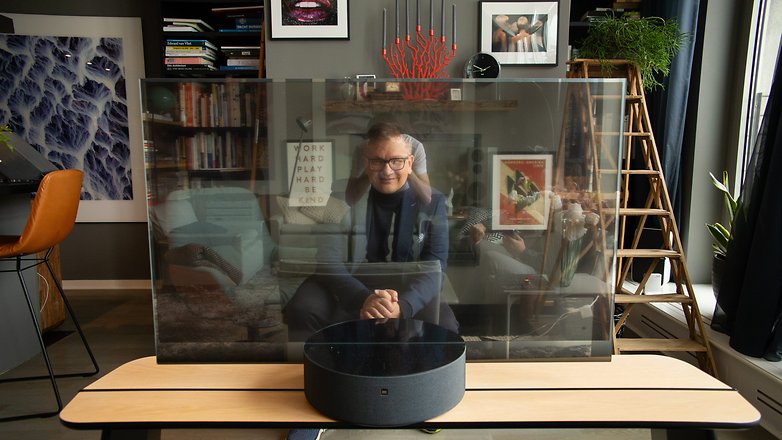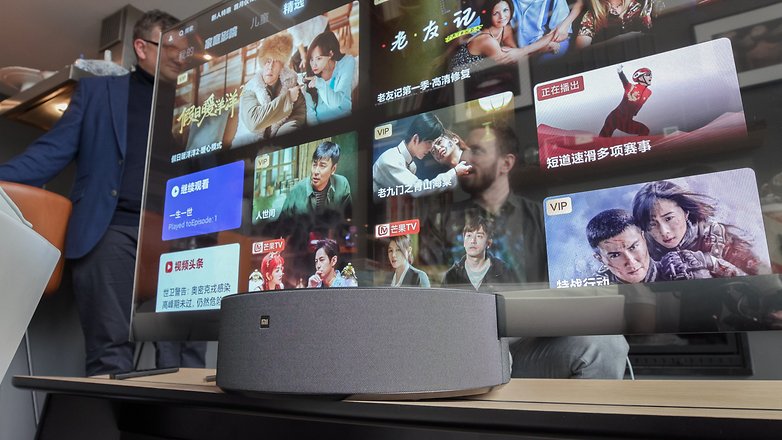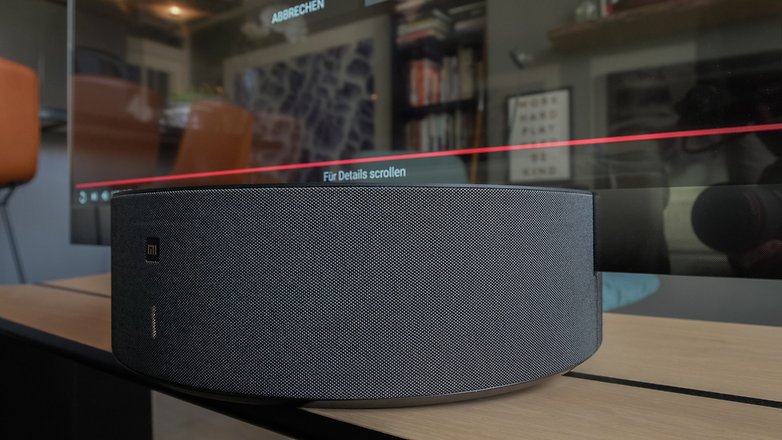The Xiaomi Mi TV Lux is the first see-through TV you can buy – at least in China. Unfortunately, at least for the time being, you have to do it with our hands-on. Or you book a flight to Xiaomi’s home country soon and pack a lot of bulky luggage on the ticket for the way back.
NEXTPITtv
Per
- transparent 😮
- transparent 😮
- transparent 😮
cons
- only to be used in dark rooms
- Display reflects heavily
- Resolution only Full HD
design
The design of the Mi TV Lux is really impressive. When switched off, the television looks as if a wafer-thin pane of glass had been inserted into a robotic vacuum cleaner. The two panes between which Xiaomi squeezes a 55-inch panel are just 5.7 millimeters thick. The Mi TV Lux could easily be a modern work of art.

If the TV is switched off, you can easily look through. / © NextPit
And somehow that’s a good thing: no matter how chic the television may be, it’s difficult to use in everyday life. Due to the round and quite large base, the TV looks strangely bulky on normal TV furniture and somehow out of place. Of course, you can’t hang it on the wall – and even with the most beautiful wall in the world it would be a waste.
We’ve probably just spent the last 100 years tailoring our living room design to TVs. Yes, the devices became flatter and flatter – but they always stood and still stand against the wall. The Xiaomi Mi TV Lux simply works differently as a television. And that brings us back to the “modern work of art” from before: In a hotel lobby, in a shopping center or in a museum, the television is certainly a crowd puller. But in the living room?
Xiaomi Mi TV Lux: Display
And then we come to the second sticking point in the living room: the suitability for everyday use of the Xiaomi Mi TV Lux. The OLED panel is fast with 120 Hz, but the resolution with Full HD is somehow more like 2015. If you look closely, you will also recognize the difficulty building a see-through television. The OLEDs are inserted as millions of small dots between the two glass panes of the display, each with small distances between them.

“Black” is transparent on the Mi TV Lux. / © NextPit
If the TV is now switched off, then all OLEDs are invisible – the same applies to dark content. With a horror film, you regularly see what is happening behind the TV, for example the wall or the rest of your 120 square meter living room. With bright content, on the other hand, it is hardly noticeable that the television is transparent. You can only see the individual pixels and look through the panel if you go very close to the display.
The fact that the Xiaomi Mi TV Lux reflects relatively strongly makes everyday use more difficult. In combination with the moderate display brightness, the television is most fun in dimmed rooms. Thanks to OLED technology, the panel has extremely stable viewing angles – so you can really admire the transparent TV from all angles. In short: The television is as impressive as it is impractical, at least as far as your own living room is concerned.

The more colorful the content on the screen, the less of the background is visible. / © NextPit
I still want one. And who knows, with the next generation, Xiaomi might nail an electrochromic coating to the rear glass pane so that the “transparency” of the television can be switched off completely if desired.
Xiaomi Mi TV Lux: Performance
What is actually in the round base of the Mi TV Lux? First of all, Xiaomi installs two 8-watt speakers with Dolby Atmos support, which make a lot of noise. The brain of the TV is also located here, consisting of a MediaTek 9650 (4x Cortex-A73) with Mali-G52-MC1 GPU. In our practical impression, this is sufficient to display the television interface smoothly. For the interface, Xiaomi relies on “MIUI for TV” based on Android TV.

Two loudspeakers, the electronics and – on the back – the connections are in the base. / © NextPit
The ports on the back of the foot have the usual equipment consisting of three HDMI, two USB-A, AV input, optical output, Ethernet port and antenna connection. In addition, the Mi TV Lux offers a modest 32 GB of internal memory.
Preliminary verdict
Bottom line, the Xiaomi Mi TV Lux is an impressive demonstration of technology – a vision. When I look at the clear OLED TV, I see the window panes of my apartment criss-crossed with display folio, as well as my bathroom mirror or the front window of my self-driving car cinemas Cars.
However, I also see that there is still a long way to go. Aside from the – admittedly huge – wow factor, however, the Mi TV Lux doesn’t have much to offer. If you want to watch TV or gamble, you need a dark room; and you can’t really put the TV in the middle of the room because of its transparency.

If you look closely, you can count the OLED pixels in the Full HD display. / © NextPit
In the end, the Mi TV Lux is interesting for early adopters with a lot of money – and for hip medical practices, modern museums or luxury hotels that want to put a piece of technical art in the lobby. Or can you think of a better use case?
